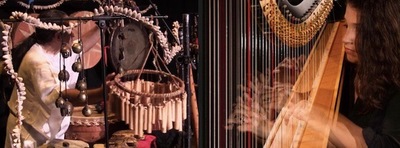Christopher Garcia knows where the deep water runs, so the multi-instrumentalist's well-established collaboration with harpist-violinist Tasha Smith Godinez at this Frogtown artspot promised well. But rapt attendees could have predicted only a glimmer of the ancient cenote they'd get pulled into.
Barrel-chested, ponytailed Garcia, a chachayote rattle wrapped around his right ankle, crouched over a floor arrayed with nonstandard instruments: water drums, hand drums, a couple of gongs, a tawitol bow, a couple of slate slabs that looked as if the Ten Commandments might've been etched on them. Godinez, younger, serious and serene, sat alongside a full-on pedal harp with multicolored strings.
Beginning with a drum's ceaseless two-beat heart-thump, Garcia eased into "Yollotl," which he described as the journey of a life. And its compressed elasticity, webbed with Godinez's drones, sweeps and dissonances, did feel like the movie that flashes before your eyes at the moment of separation. Garcia scraped the slates to accentuate the abrasions the traveler encounters, and if the life seemed brief, it was mainly because clocks and ledgers had magically departed from local consciousness.
Godinez followed with Andres Martin's "Postales del Alma," a composition for solo harp that found beauty in the progression of grief. Harmonically complex and melodically romantic, it hurt and soothed in the same breath, as Godinez augmented her instrument's wide tonal palette with heart-tugging effects such as a ribbon drawn across a string or an overtone conjured with quick hand muting. It was like a grand old Hollywood drama without the corn.
Garcia picked up a pre-Columbian clay huilacapiztli to blow a spring breeze into a gradually unfolding "flower song." And the duo brought out the multiple resonances of the Mexican folk lament "La Llorona" (Godinez stroking the melody on violin and amplifying on harp), whose evolving themes have included lost love, brutal conquest and, in the jazz legacy Garcia perpetuates, a tribute to a fallen revolutionary as adapted in 1969 for "Song for Che" by Charlie Haden's Liberation Music Orchestra.
At one point Garcia removed the gourd resonator from a water drum, scooped water into it and poured it back into the base -- water into water, as the poet Lewis MacAdams has written. The tacit acknowledgment of eternal cycles marked one more reason why we sat so quietly, hearing and feeling things words can't express.

